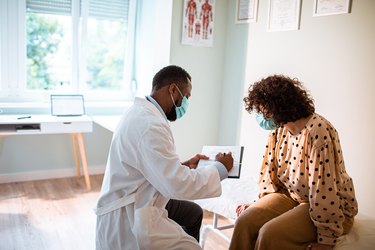
Many of us have anxiety about going to the doctor's office. Whether you're scared of needles or worried about your physician criticizing your weight, it's common to feel uneasy in a medical setting.
For some people, the stress can even cause a temporary spike in blood pressure.
Video of the Day
Video of the Day
If this sounds familiar, you might be dealing with white coat syndrome, or white coat hypertension, a condition named after the traditional white coats worn by doctors.
Turns out, the phenomenon is incredibly common: Approximately 1 in 5 people are affected by white coat syndrome, according to Harvard Health Publishing.
While it's typically harmless, white coat syndrome can be difficult to diagnose because it often looks like hypertension (i.e., chronic high blood pressure). And in some cases, white coat syndrome could actually be a sign of more serious heart-related issues.
We spoke with Jodie Skillicorn, DO, a holistic psychiatrist in Ohio, to learn why white coat syndrome happens and what you can do to better manage your blood pressure at the doctor's office (and in other high-stress situations).
What Is White Coat Syndrome?
"White coat syndrome is the term used to describe a spike in blood pressure that occurs only at a doctor's office, due to anxiety and fear," Dr. Skillicorn says.
Unlike people with classic hypertension, people with white coat hypertension only experience high blood pressure in a medical setting and have normal readings at home and other non-medical settings.
Keep in mind, a normal blood pressure level is less than 120 millimeters of mercury (mm Hg) for the top number, and less than 80 mm Hg for the bottom number, according to the Cleveland Clinic.
If either (or both) of these numbers are consistently high, you could be dealing with high blood pressure.
Is White Coat Syndrome an Anxiety Disorder?
Though the stress of going to the doctor can cause feelings of anxiety and high blood pressure, white coat syndrome is not technically an anxiety disorder, Dr. Skillicorn says.
In some cases, though, the syndrome can be part of a phobia called iatrophobia — an extreme fear of doctors and medical tests, she says. This happens when a person's fear becomes severe and all-encompassing (i.e., it keeps them from going to the doctor).
To be categorized as a phobia, though, other symptoms (in addition to a high blood pressure reading at the doctor's office) would need to be present, Dr. Skillicorn says.
Other signs of iatrophobia include the following, per the Cleveland Clinic:
- Dizziness
- Dry mouth
- Extreme feeling of dread or terror
- Nausea
- Profuse sweating (hyperhidrosis)
- Rapid breathing/heart rate or heart palpitations
- Shaking or trembling
- Refusing medical care even if you're very sick
What Causes White Coat Syndrome?
Biologically speaking, white coat syndrome is often started up by your body's "fight or flight" response. This is a physiological reaction that happens when you perceive a threat, according to the Cleveland Clinic.
When your body goes into "fight or flight" mode, you produce stress hormones that speed up your heart rate and constrict your blood vessels, resulting in a rapid increase in blood pressure, per Harvard Health Publishing.
For white coat syndrome in particular, the threat or danger you feel is often related to previous "scary or bad experiences at the doctor's office, which are, unfortunately, all too common," Dr. Skillicorn says.
You could also be worried about very understandable things — like hearing bad news or finding out something is wrong with your health, she adds.
"For some, the white coat itself is seen as a symbol of authority and can make you feel nervous," Dr. Skillicorn says.
When your body is conditioned to react like this (as if it's responding to danger), the pattern can be difficult to break. Even the fear of getting a high blood pressure reading, because of past high readings, can become a vicious cycle, Dr. Skillicorn adds.
There are a few groups of people who are most at risk for white coat syndrome. They include the following, per the Cleveland Clinic and Dr. Skillicorn:
- Those with existing hypertension: Fifteen to 30 percent of people with high blood pressure also have white coat syndrome, per the Cleveland Clinic.
- People with anxiety: It doesn't help that most blood pressure readings are taken at the start of the appointment (when you're most nervous) and doctors sometimes have an alarming reaction to high readings. This can make you feel even worse, Dr. Skillicorn says.
- Those over age 50: Older adults tend to visit the doctor more often, which could increase their nerves each time.
- People assigned female at birth: People AFAB are more likely to have anxiety in general, per the Anxiety & Depression Association of America.
- People with obesity: Weight bias still exists in the medical field, which can make it difficult for people with overweight to feel welcome or comfortable at the doctor.
- People who do not use tobacco products: The reasons here aren't totally clear.
How Is White Coat Syndrome Diagnosed?
It's important to get an accurate diagnosis when it comes to white coat syndrome vs. hypertension.
If your doctor only relies on a high blood pressure reading taken in the office (when you're most nervous), you might be prescribed a medication that you don’t actually need, according to the Cleveland Clinic.
Your doctor can figure out whether you have white coat syndrome by giving you a wearable blood pressure monitor. This device tracks your blood pressure over the course of 24 hours and can give your doctor a better picture of your normal blood pressure levels, like when you're resting at home, per the Mayo Clinic.
If it turns out you do have hypertension, your doctor may prescribe you blood pressure medication to bring down your numbers, because chronic high blood pressure can increase your risk of coronary artery disease, stroke, heart attack and other serious health problems, per the Cleveland Clinic.
Is White Coat Syndrome Dangerous to Your Health?
White coat syndrome isn't directly harmful to your health. In fact, "blood pressure is constantly fluctuating," Dr. Skillicorn says. "Our bodies can handle higher blood pressures for shorter periods of time, like when we exercise, for example," she adds.
Your blood pressure reading can also fluctuate depending on the time of day you take it, whether you were resting before taking it, the amount of noise around you while taking it and how you're feeling emotionally when you take it, per the Cleveland Clinic.
In some cases, however, white coat syndrome can become chronic high blood pressure if left untreated: An estimated 5 percent of people with the syndrome are diagnosed with chronic hypertension each year, according to the Cleveland Clinic.
And research suggests white coat syndrome can be a precursor to other heart-related problems, according to a June 2019 meta-analysis in the Annals of Internal Medicine. The review says people with untreated white coat syndrome had a 36 percent higher risk of heart attack, stroke and other heart-related issues in the long-term.
The review also mentions that people who are already medicated for high blood pressure, but still get blood pressure spikes in medical settings (called white coat effect), did not have a higher risk of heart disease.
Ultimately, it's important to ease your nerves at the doctor so it doesn't turn into a more serious issue.
How to Manage and Treat White Coat Syndrome
If your blood pressure readings are normal at home, you likely won't need to do much to treat the spikes you get at the doctor. But your doctor may still want to keep an eye on you, in case your white coat syndrome becomes hypertension in the future.
While blood pressure medications are sometimes recommended for people with white coat syndrome and other heart issues, lifestyle changes are more often recommended as the first line of defense. Try some of the following techniques to relieve anxiety about going to the doctor:
1. Practice Deep Breathing
Deep belly breathing (also called diaphragmatic breathing) is one of the best ways to calm yourself down in the moment because it activates your parasympathetic nervous system, putting you in "rest and digest" mode instead of "fight or flight."
You can try a short exercise while you're at the doctor, or try it at home as a designated daily practice (or both).
"A daily 20-minute practice of focusing on your breath can reduce nervous system reactivity, and reduce blood pressure as well," Dr. Skillicorn says.
Here are the steps to do it, according to the Cleveland Clinic:
- Lie on your back on the floor or in bed. You can put pillows under your head and knees to support yourself.
- Place one hand on your upper chest and the other just below your rib cage. This will allow you to feel your diaphragm move as you breathe.
- Breathe in slowly through your nose so your stomach expands, causing the hand on your stomach to rise. The hand on your chest should remain as still as possible.
- Exhale slowly through pursed lips as you tighten your stomach muscles, so they contract. The hand on your stomach should lower, while the hand on your upper chest stays still.
- Repeat as many times as you need.
You can also try belly breathing while sitting in a chair if it's more convenient.
2. Ask Your Doctor to Take Your Blood Pressure at the End of Medical Appointments
As mentioned before, doctors often check your blood pressure at the beginning of your appointment, when "people tend to be most anxious," Dr. Skillicorn says.
Next time you go to the doctor, ask if you can have your blood pressure taken again at the end of the appointment to see if it has decreased since your first reading. "Many nurses will agree the second reading tends to be more accurate," Dr. Skillicorn says.
"Small changes [like this] in the medical setting could do so much to reduce this problem," she adds.
3. Exercise Regularly and Try a Plant-Based Diet
Getting regular exercise has been shown to help reduce stress and the risk of hypertension and other chronic diseases, Dr. Skillicorn says.
And while all forms of exercise are helpful, gentle movements like yoga and qigong (which focus on the mind-body connection) especially have been found to lower stress reactivity and blood pressure, in particular, she says.
Aiming for a nutritious, plant-based diet is another way to improve your blood pressure readings. The Mediterranean diet, for example, has been found to help reduce blood pressure while also reducing your risk of heart disease and diabetes, according to Harvard Health Publishing.
4. Monitor Your Blood Pressure at Home
Tracking your own blood pressure at home is a helpful way to reassure you and your doctor that your blood pressure is normal most of the time, Dr. Skillicorn says.
You can buy a portable blood pressure monitor to use at home or take your blood pressure for free at most nearby pharmacies.
5. Find a Doctor Who Makes You Feel Comfortable
Don't be afraid to tell your doctor that you get nervous at the doctor's office. The right doctor will be empathetic and do their best to create a calm environment.
Unfortunately, "some doctors don't recognize and/or normalize this very common issue," Dr. Skillicorn says.
Make sure your doctor gives a bigger picture of your overall health status, instead of just focusing on one high blood pressure reading. And keep in mind that just because you opened up to your doctor doesn't mean you still won't be nervous at times.
This is why it's important to form a trusting relationship with your doctor, who can help you through your anxiety, per the Cleveland Clinic.
Remember: You can always find a new doctor if the one you see isn't empathetic to your situation.
Tip
If the reason you're going to the doctor doesn't require any initial tests or screenings, ask if you can schedule a telehealth appointment. That way, you can get medical care in the comfort of your own home, and get used to speaking with the doctor without getting nervous.
6. Speak With a Therapist
If you feel you can't cope with white coat syndrome on your own, talking it out with a mental health professional may help.
Talk therapy can serve as a safe space to work through any stress and anxiety you have surrounding the doctor, Dr. Skillicorn says.
You could even try scheduling therapy appointments a day or two before your doctor's appointment to help you prepare.
Other Tips to Manage White Coat Syndrome
On the day of your doctor’s visit, try the following tips to help you relax, per the Cleveland Clinic:
- Give yourself plenty of time to get to your appointment so you don’t feel stressed.
- Don’t smoke, drink coffee or exercise for 30 minutes before your appointment.
The Bottom Line
White coat syndrome is fairly common. The temporary blood pressure spike you get is not directly harmful to your health, but it may lead to long-term health issues like hypertension if left unmanaged.
Managing stress, communicating with your doctor about your nerves and checking your blood pressure while resting at home are all helpful ways to reduce your anxiety about going to the doctor.
If your doctor suspects you're dealing with something more than white coat syndrome (like hypertension), they may have you wear a blood pressure monitor and decide if you need to take blood pressure medication.
- Cleveland Clinic: “White Coat Syndrome”
- Cleveland Clinic: “Iatrophobia (Fear of Doctors)”
- Harvard Health Publishing: “Could white-coat hypertension harm your heart?”
- Annals of Internal Medicine: “Cardiovascular Events and Mortality in White Coat Hypertension: A Systematic Review and Meta-analysis”
- Mayo Clinic: “White coat hypertension: When blood pressure rises in a medical setting”
- Cleveland Clinic: “High Blood Pressure (Hypertension)”
- Cleveland Clinic: “Diaphragmatic Breathing”
- Cleveland Clinic: “Biofeedback”
- Harvard Health Publishing: “What is a plant-based diet and why should you try it?”
- American Heart Association: "Understanding Blood Pressure Readings"
- Harvard Health Publishing: "Understanding the stress response"
- Anxiety & Depression Association of America: "Facts"
Is this an emergency? If you are experiencing serious medical symptoms, please see the National Library of Medicine’s list of signs you need emergency medical attention or call 911.





